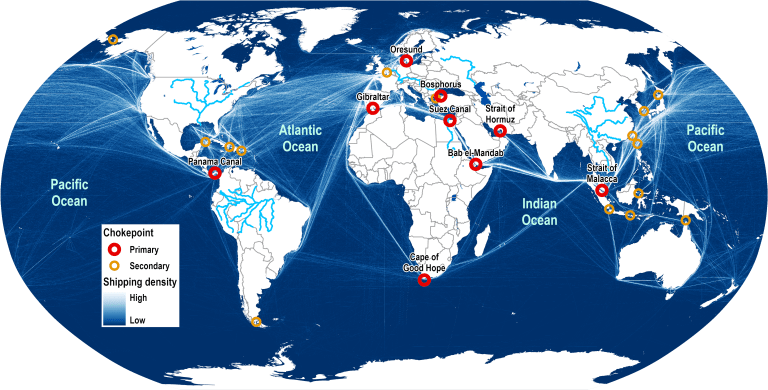
Source: Shipping density data adapted from National Center for Ecological Analysis and Synthesis, A Global Map of Human Impacts to Marine Ecosystems.
Oceanic masses and rivers are the two primary components of maritime circulation, and oceanic masses account for 71% of the terrestrial surface. The four major oceans relevant to maritime circulation are the Pacific (165 million square km), the Atlantic (82 million square km), the Indian (73 million square km), and the Mediterranean (2.5 million square km). The Pacific is by far the largest ocean and supports about 25% of the global maritime trade, a share that is growing rapidly. Only a small portion of it is used for commercial transportation purposes. The northernmost parts of the Atlantic as well as the southernmost parts of the Atlantic, Indian and Pacific oceans are not much used mainly because of hazardous navigation conditions (mainly ice) and their remoteness to the centers of economic activity.
The shipping density is derived from the paths of mobile data points of a sample of commercial vessels (about 11% of the world fleet) counted over a year on a grid of 1 square kilometer cells. It is not weighted by ship size and is not necessarily fully representative of all commercial activity. Even if maritime transportation has experienced remarkable improvements in its safety and reliability, maritime routes are still hindered by dominant winds, currents, and general weather patterns. The North Atlantic and the North Pacific (50 to 60 degrees north) are subject to heavy wave activity during the winter that sometimes impairs navigation, and may cause ships to follow routes at lower latitudes, thereby increasing route lengths. During the summer monsoon season (April to October), navigation may become more hazardous on the Indian Ocean and the South China Sea.
About 50 countries have an inland navigation network of more than 1,000 kilometers. Rivers may not be useful for commercial navigation if their orientation does not correspond to that of transport demand. Thus, many of the major rivers of Russia flow north-south, while the main flows are east-west. Shallow draft and extensive obstacles, such as rapids, may also limit navigation. However, many rivers, such as the Rhine or the Chang Jiang, are significant arteries for water transport because they provide access from the oceans to inland markets. Yet, their main purpose remains to connect regional markets. Geographically, maritime activities can be divided into two major categories:
- Interior (Fluvial) Waterways. Fluvial transportation is well suited to transport bulk cargo, has low costs, and limited environmental externalities. Industrial countries with large waterway systems such as the Volga, the St. Lawrence / Great Lakes, the Mississippi, and the Rhine rely in part on fluvial transport. All these networks have a tree-like structure that has been broken by the construction of canals linking different tributaries. Domains of inland navigation in North America, Europe, and China are not equivalent in terms of ship sizes implying different operational characteristics. Most waterways are solely used for bulk cargo. However, inland integration with maritime shipping is emerging with container barge services, especially in Western Europe. Growth and diversification of activities on Chinese waterways have also been a dominant trend as China integrated into the global economy and as the growth of its domestic economy.
- Transcontinental Waterways. Seaborne trade has experienced strong growth, which is linked with the reliance on energy, minerals, and agricultural products trades. These trades rely on economies of scale and are carried by large maritime companies. A division of labor and capital in the maritime industry has emerged, with markets, technology, and capital provided by developed economies and labor by developing economies.